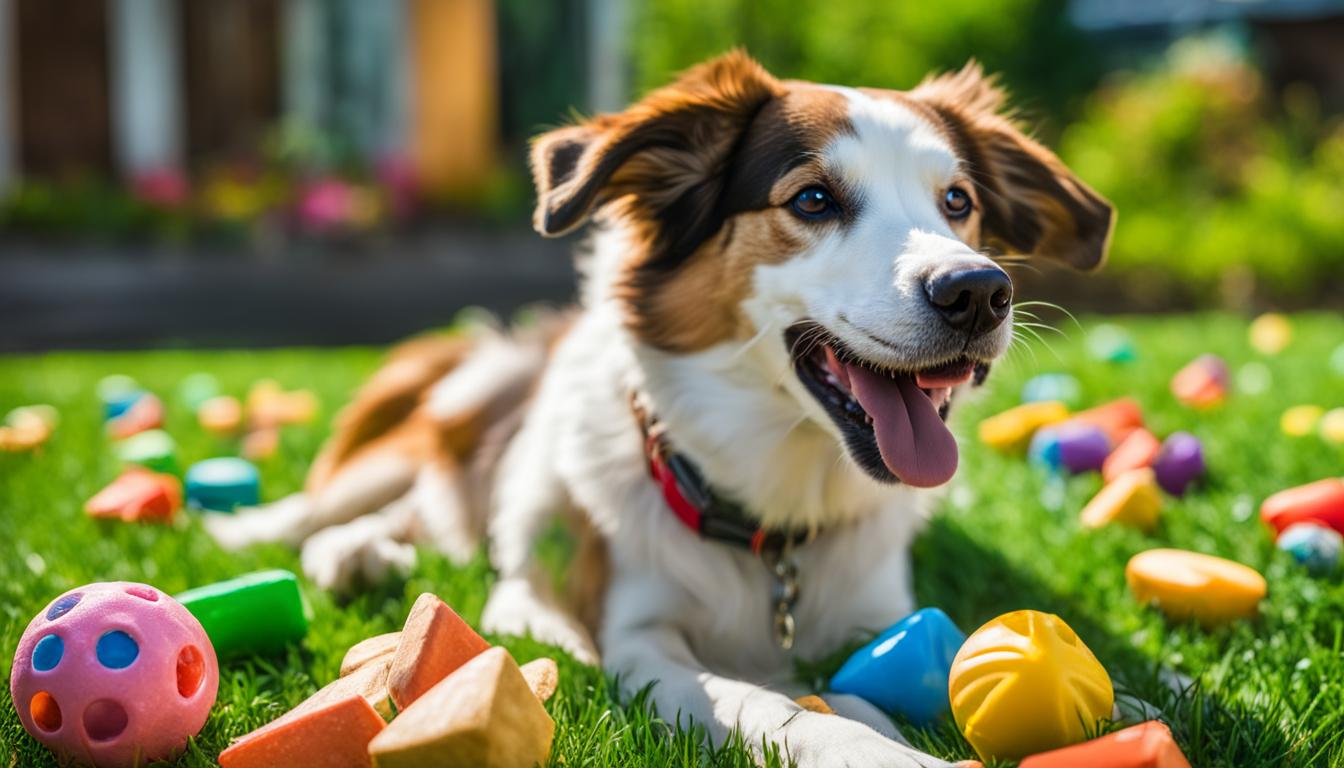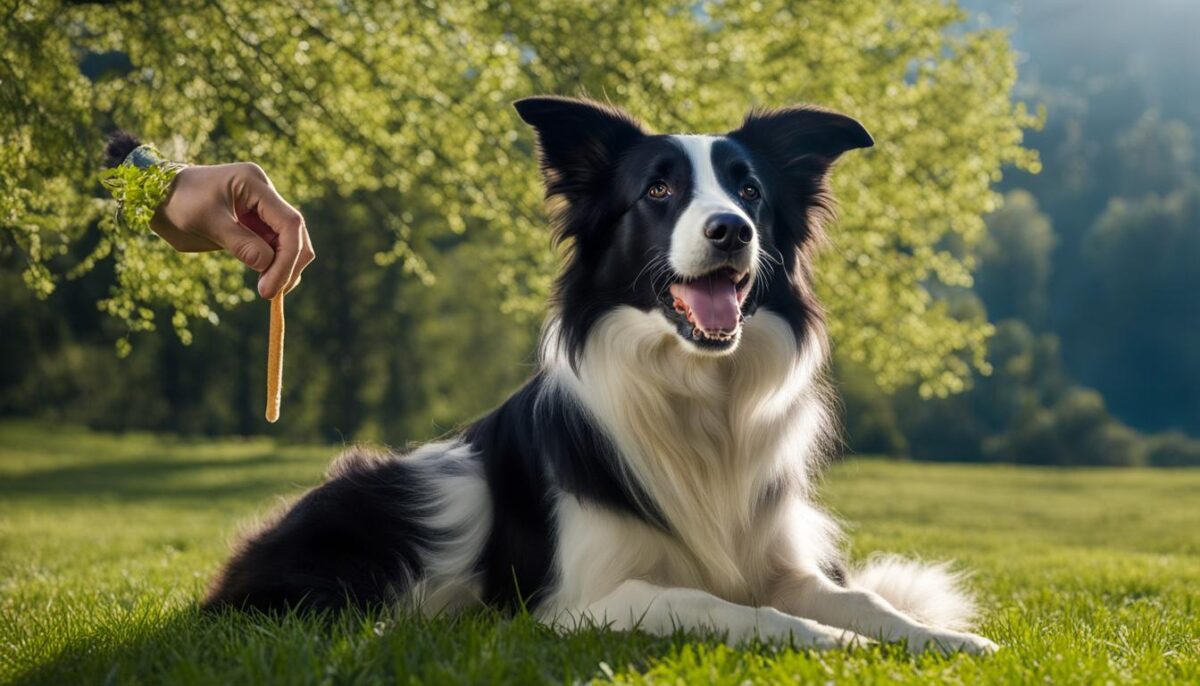Do you want to have fun with your dog and learn new ways to talk to each other? You can teach your furry friend to “speak”! That’s right, with some simple dog training, you can get your pup to bark when you ask. This dog trick is not just for fun, it also helps with effective pet communication. When your dog barks on command, it can stop them from barking too much at other times.
Getting started is easy. You just need some tasty treats or a fun toy to make your dog happy. When they get really excited, they will start to bark. That is when you say “speak!” and give them a treat. If you do this more times, they will learn what “speak” means.
Are you ready to try? Let’s make talking with your dog even better with a cool new command!
Key Takeaways
- Teaching “speak” is a dog training game you and your pet can enjoy.
- Dog tricks like “speak” help you and your dog understand each other.
- Use treats or toys to encourage your dog to bark.
- When your dog barks, say “speak!” and reward them.
- Keep doing this and your dog will learn the dog speak command.
The Basics of Teaching Your Dog to Speak
Ready to teach your furry friend how to “speak” on command? It’s a fun trick and a great way to improve communication between you and your dog. Let’s start with the essentials for successful dog behavior training.
Have Your Reward Ready
You know your dog loves treats, toys, and your praise. Having these dog rewards readily available is crucial for encouraging good behavior. This method of positive reinforcement lets your dog know they did something right.
Identifying Barking Triggers
Different things may make your dog bark. Maybe they get excited when they see other animals or when someone comes to the front door. Finding what naturally makes your dog bark is the first step in this training adventure.
Capturing the Behavior with a Command
When your dog barks, it’s time to introduce the command like “speak” or “talk.” Are you using a clicker? That’s great! The sound of the clicker marks the exact moment your dog gets it right. Remember, if you asked for a bark and got one, it’s reward time!
Consistency makes all the difference. Always give dog rewards right after the bark, and try to get just one bark at a time. Soon, your dog will be speaking on command like a pro!
Understanding Dog Barking Cues:
| Cue Type | Examples | Training Response |
|---|---|---|
| Visual | Squirrels outside, a new person entering the house | Introduce “speak” when your dog notices these cues |
| Audio | Other dogs barking, doorbell ring | Use “speak” at these sounds, then provide a reward |
| Emotional | Excitement during playtime, anxiety when alone | Encourage controlled barking with “speak,” followed by praise |
Teaching your dog to bark on command is a big part of dog behavior training. Take it one step at a time, celebrate the small wins, and have fun talking to your dog!
How to Train a Dog to Speak: Establishing the Speak Command
When you want to teach dogs training commands, one of the most fun things to start with is dog speak training. Teaching dogs to speak, or bark on cue, isn’t just for fun—it’s part of dog communication. To start, find a quiet time when you can focus on training without distractions. You’ll need some tasty treats that your dog loves. This will make learning super exciting for them!
Here’s a simple guide to follow:
- Watch for times when your dog naturally barks and say “speak!”
- Right after they bark, give them a treat and lots of praise.
- If they’re quiet, try knocking softly on a door to encourage a bark.
- Once they start to understand, say “speak” and wait for the bark before the reward.
Remember, dogs are all different. Some may learn quickly, while others take a bit longer.
Patience is key! Keep practicing, and always end on a positive note with lots of belly rubs or a fun game. It’s like when you learn something new and get a gold star. Dogs like to feel they’ve done a great job too!
| What To Do | What Not To Do |
|---|---|
| Use happy, excited tones | Get frustrated or angry |
| Giving treats right after barking | Waiting too long to give the reward |
| Practice in short, fun sessions | Train for too long and make it boring |
| Be consistent with the command | Use different words for the same trick |
Awesome work! Keep it up, and pretty soon your dog will be speaking on command and impressing all your friends!
Enhancing Communication with Hand Signals and Tips
Teaching your dog hand signals for dogs can make talking with them even better. After your pet knows how to “speak” when you say the word, you can start using your hands to talk, too. A cool hand signal to use is to show your open hand and then bring your fingers into your palm one by one. This hand move is a quiet way to tell your dog what to do. It works with your voice or all by itself.
Why use hand signals? They’re great for advanced dog training because sometimes you can’t speak or your dog can’t hear you. Plus, it’s fun! It’s like learning a secret language with your furry friend. But, remember to be consistent. If you mix up signals, your dog might get confused. Always give the same hand signal for the same request to keep your training on track.
When you’re training your dog, using hand signals is part of something called non-verbal dog commands. You don’t always have to talk to tell your dog what to do. Hand signals help you do that without saying a word. This is super useful when you’re in a quiet place or if your dog is far away from you.
Training should always be about making sure your dog behaves in a good way. That means no wild barking whenever they feel like it. If you want to teach something even cooler, you can show them how to “whisper,” which is a quiet bark. Make sure you’re thinking of your neighbors. Loud barking can be rude, so practice teaching your dog to “speak” and “whisper” for short times, and not too often.
If you keep practicing, you and your dog will get great at using dog obedience signals. Then, going to the park or walking around the neighborhood will be easy and fun. Your dog will know exactly what you’re asking, with just a simple movement of your hand!
Conclusion
When you’re teaching your dog to speak, remember it’s like learning a fun new game. Some dogs might pick up the rules super fast, while others might need a little more time to understand what you’re asking. The key is to keep practicing with your pup and being super patient. Stick with the plan, use those treats or toys they love, and say “speak” the same way each time. And don’t forget to celebrate the small wins along the way!
Practice and Patience in Dog Speak Training
Strong practice and lots of patience are super important for successful dog training. Always be clear with your commands and keep giving those rewards to help your furry friend understand. It can be exciting when your dog does things right, but if they don’t get it right away, that’s okay too. Keep at it, and before you know it, they’ll be speaking on cue! Just remember, all good things take time, and training your dog is one of those things.
The Fun and Function of the Speak Command
When your dog learns to “speak,” it’s not just a cool trick to show your friends. It’s also great for when your dog needs to tell you something, like wanting to go out. Plus, it’s a step towards more awesome training goals, like the AKC Trick Dog titles. Nowadays, you can show off your dog’s skills with a video and join in on the fun with other dog owners. Keep reinforcing that good dog behavior, and you’ll see amazing results. Keep being an awesome dog trainer, and you’ll build a super bond with your pup!
FAQ
What are some effective methods for communicating with my dog?
Teaching your dog the ‘speak’ command is a fun and effective way to communicate with them. Positive reinforcement through treats, toys, or praise when they correctly follow your command is essential. It’s also useful to add hand signals to your training to enhance non-verbal communication.
How can I train my dog to bark on command?
You can train your dog to bark on command by using a consistent verbal cue like ‘speak’ or a clicker right when they bark naturally. Reward them immediately after they bark with treats, toys, or praise. Practice this in a variety of situations so they learn to speak on cue.
What are the effective pet communication tricks I can teach my dog?
Besides the ‘speak’ command, you can teach your dog other communication tricks such as ‘sit,’ ‘stay,’ ‘come,’ or even more complex behaviors like ‘whisper’ for a quieter bark or ‘fetch’ an item. Each trick reinforces your dog’s understanding of commands and strengthens your bond.
Can clicker training be integrated into teaching my dog the ‘speak’ command?
Absolutely! Clicker training is a form of positive reinforcement that can effectively be used to mark the exact moment your dog performs the desired barking behavior. After the click, provide a treat to reinforce the action.
What should I be careful about when training my dog to ‘speak’?
It’s crucial to ensure that while training your dog to ‘speak,’ you maintain consistency and do not accidentally encourage excessive or inappropriate barking. Only reward your dog when the command is given and keep training sessions short to avoid over-excitement or frustration.
How can I reinforce my dog’s ‘speak’ behavior?
Reinforce your dog’s ‘speak’ behavior by being consistent with rewards and patient with practice. Use high-value treats or favorite toys as rewards, and integrate the command into everyday situations to strengthen their understanding and responsiveness.
What are some signs that my dog is ready to start learning the ‘speak’ command?
Dogs that are attentive, engaged in training, and exhibit a desire to communicate are likely ready to start learning the ‘speak’ command. Look for natural barking triggers as a good opportunity to introduce and practice the new cue.
Can training my dog to ‘speak’ be useful beyond performing tricks?
Training your dog to ‘speak’ has practical benefits, such as signaling when they need to go outside or deterring potential intruders. It can also lead to earning AKC Trick Dog titles, which can be achieved by video submission and adds a fun goal to your training regimen.
How can hand signals improve my dog’s obedience and understanding?
Hand signals provide a visual cue that can accompany or replace verbal commands, offering another way for your dog to understand your instructions. They can be particularly helpful in noisy environments or as your dog’s hearing changes with age.


